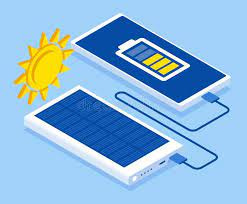
Dear Ms. Smartphone: I recently got a new watch (the Garmin) that has GPS and it uses solar power to recharge itself. So, I only end up recharging it every 2 months or so. With the earthquake this past week, I was wondering why we do not have phones that can recharge with solar power as well. Solar charging for phones could be very useful. Perry, Sausalito
Dear Perry: It’s a timely question (pun intended) since many people are restocking their earthquake kits this month. We have all been reminded of the essential role that smartphones have in disaster management. The 5.1 magnitude temblor demonstrated something new: 2.2 million Bay Area residents received advance notifications via the built-in Android technology or on a separate app for iPhones. It would be great if we all had phones sitting in the sun, fully charged and ready to respond.
I looked up the features on your watch and they are indeed impressive. The Enduro and other recent Garmin watches can last up to 65 days ( 2 months!) with solar assistance. If the energy intensive GPS (global position system) is used with solar Garmin says the devicelasts up to 80 hours of use with the regular battery and up to 300 hours with an extended one. That will certainly take you further than your smartphones today!
So why don’t smartphones adopt sunlit battery management systems like those found in your watch, or even on a desktop calculator? The easy answer is that phones do a lot more. The multi-functional battery is needed to take pictures, browse the Internet, send email, and use GPS. Always going on in the background is the battery draining search to find and connect to new cell towers when you move about. That is essentially a GPS function too.
Less Heat:
Phones do not like it hot. If you think back to this sizzling past summer you will recall warnings to keep your phone out of direct sunlight and to remove them from the patio table outdoors and the car dashboard. That’s because phones are vulnerable to extreme temperatures and start to strain when the outside temperatures rise. Heat will damage the electronics and at an extreme, lead to battery leakage and fires.
But, that quest to match phones to solar is not new! A few early prototypes, like the Nokia 1601 and 1611 did have solar powered batteries and worked best in sunny Kenya! In those tests, circa 2009, an hour of charging provided electrical energy for a 5 to 10 minutes call. Another attempt, the Samsung Blue Earth Phone never took off, but it had an unique eco display with a step counter that calculated how much less C02 you would release into the atmosphere if you walked instead of taking a car trip. The solar panels affixed to the back panel were not sufficient to power all of the phone’s functions, even back in those 3G days.
One of the reasons that phones are slower to incorporate solar than say Garmin watches comes down to a timing issue. Your watch is exposed to the sunlight throughout the day. Phones tend to be buried in the recesses of our pockets or bags. At night, when we are more inclined to leave them out, then it’s dark. It’s not to say that a work-around will not be developed. One that has been touted for some time is a high-tech chemical film that sits between the display and touchscreen to change light into electricity.
More Bright Ideas:
In the interim, I have a couple of suggestions should truly need a 24/7 phone. If you are using the GPS on your watch for situations, say you go camping or hiking, you could also get that backup with the brand new new satellite-connecting phone. But that raises the need to keep the phone charged and ready to use. On Amazon you will find a number of auxiliary solar chargers. Some connect directly into your phone using a cable, and others power an outside power pack that you then connect to the phone. (Remember the cables!). While I don’t own one, the reviews seem to indicate that the devices work well….once they are full charged and that will require leaving them for 50 to 60 hours in sunlight fresh out of the box.
A second best method might be to spread the electrical load between your devices. You could use a Japanese style flip phone for durability (keep it in your pocket and recharge only occasionally) and a tablet for being able to look at web pages or email. That will significantly cut down your power usage, as you already own the watch for navigation!
Sunny!
Third, you could be using solar! If you have installed solar panels at home (or are planning to get them soon) then your phone will pull down all that solar energy when you plug in with a conventional charger! The system’s battery management system should keep your entire household up and running after an earthquake or other natural disaster.

Leave a Reply
You must be logged in to post a comment.